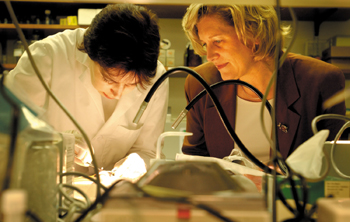
Lynn Matrisian observes Barbara Fingleton, research assistant professor, as she performs a mouse surgery in the lab. (photos by Dana Johnson)
A win-win situation — Matrisian leads Cancer Biology with success
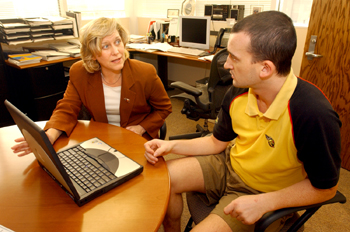
Matrisian meets with Conor Lynch, a post doctoral fellow in her lab, about a presentation he is preparing.
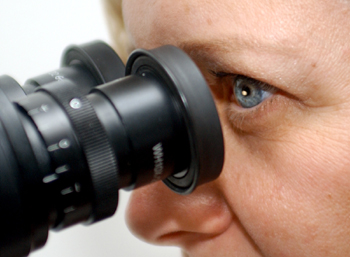
Matrisian is known throughout the world for her work to understand proteolytic enzymes.
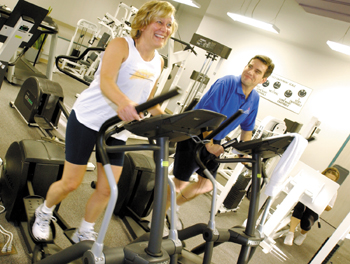
Matrisian laughs as she works out on the elliptical trainer at the Dayani Center with Colin Armstrong. She works with a personal trainer there at least twice a week.
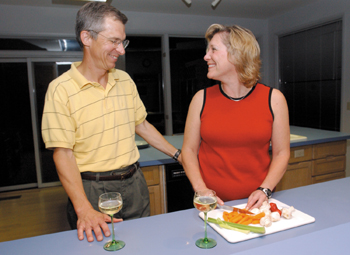
Lynn and her husband Paul complement each other, especially in the kitchen.
When Lynn McCormick was learning to drive through deep winter snow up the hill to her Pennsylvania home, her father gave her some advice that set the tone for her life and career:
If you can’t go left, go right.
“The idea is that, if you stumble or get stuck, you should always look for another avenue to accomplish your goals,” says McCormick, now known as Lynn M. Matrisian, Ph.D., Ingram Professor of Cancer Research and chair of the department of Cancer Biology.
It is advice that has served Matrisian well, from her college days studying medical technology — a major selected because it would clearly lead to a job — to her current roles as department chair, senior scientist and mentor of junior investigators, especially women in academic medicine and research.
For Matrisian, the goal in all things is win-win, which her husband, Paul, is quick to point out, is not the same thing as compromise. “I’ve learned that from her,” he says. “When you compromise, both sides give up something. Lynn always keeps the end objective in mind, with the goal of everyone getting what that they want — win-win.”
This philosophy has shaped a woman who is at the same time determined and flexible, someone who has learned that to reach her goals, she has to accept that she can’t control all things. Being flexible — going left if you can’t go right — is the only way to reach the desired outcome, whether that’s making it up a steep hill in deep snow, building a brand new basic science department, or figuring out how to defeat cancer.
Matrisian grew up in Montgomery, Penn., near Williamsport, in the north central part of the state. Montgomery is a town of only 2,500, but Williamsport is better known, with its claim to fame as the “Home of Little League Baseball.” She was the oldest of three. Her parents, Delmar and Marion, did not have the opportunity to finish college, and for Matrisian, going to college was simply a means to an end — getting a job. She went to Bloomsburg State College, now university, which was a 90-minute drive from home — not too close, not too far. She initially majored in biology and French.
“I thought I might be an elementary school teacher or maybe an airline stewardess,” Matrisian recalls. “I wanted to get someplace foreign, and I kept thinking, ‘If I could just get to Montreal, that would be really neat.’”
The college offered a major in medical technology. “I had never heard of it, but it gave you a good job when you got out of school,” she says, so she changed majors. Matrisian spent three years in classes at Bloomsburg, then spent her fourth year in Lancaster learning the practical skills of the job. “I had the white uniform and everything.”
As she neared graduation in 1975, however, Matrisian discovered that the job that had been her end goal was no longer enough. “I was learning so much in school, but I realized that after school, all that would change. I wouldn’t be learning any more. All that would be new would be the patient’s name on the tube.”
Matrisian got up the nerve to talk to Dr. Richard Ladda, a genetics counselor that she heard of at the medical school in Hershey, Penn. He offered her a job in a karyotyping lab. It only paid $8,000 a year, significantly less than the $12,000 she could have made in a clinical lab, but it met her goal for continued learning and it eventually offered her exposure to biomedical research.
“I just became fascinated with the research lab,” Matrisian says. “I did some master’s work at Millersville State College and took some med school classes.”
There, she met Paul Matrisian, who was working in a nearby lab. They dated, then married and just weeks later, the newlyweds hopped into a rented U-Haul and headed to the University of Arizona, where Paul had been offered a job.
It was an eventful trip, to say the least.
“We were hit by two tornadoes,” Matrisian says. “The U-Haul was flooded the first night. We had a flat tire in New Mexico. The water pump went out. We made it finally, and I was naïve enough to just start knocking on doors. I had a letter of introduction to Jeff Trent — now at the Human Genome Institute — so I talked to him and he sent me to the Molecular Biology Program at the med school. As a technician, I had done some epidermal growth factor receptor binding, so I had the desired technical skills. I couldn’t get a stipend but they did waive my out-of-state tuition.”
She became a graduate student in the lab of Bruce Magun, who is now chair of Anatomy and Cell Biology at Oregon Health Sciences Center.
Shortly after Matrisian got her Ph.D. degree in 1982, Magun left Arizona to work in the laboratory of Pierre Chambon in Strasbourg, France, leaving Matrisian in charge. “I published some papers and learned about running a lab,” she says. “It was a good experience.”
Though now living in the desert southwest, Matrisian still hadn’t realized her dream of getting “someplace foreign.” She set her sights not for Canada, but for France.
“I wanted to work with Chambon. He said yes, but only if I got my own grant.” So Matrisian wrote a grant for an NIH fellowship. She received a good score, but the NIH budget hadn’t yet passed so she faced leaving her job and her country to begin a job and life in France without knowing if she had the grant.
“I finally called the program officer at NIH and I asked, ‘If you were me, would you buy this airline ticket?’” The response was “yes,” so she took a chance. She and Paul left for France in January 1984.
“We had a portable computer, a big daisy-wheel printer and all the clothes we could carry,” Matrisian says. “We flew to Belgium and took a train to France. Customs almost wouldn’t let us in.”
Her grant came through. The Matrisians found a studio apartment. Paul volunteered for Chambon’s company, Transgene, while his work papers were processed. They spent the next two-and-a-half years there. She describes it as a magical time.
By the time the fellowship came to an end, Matrisian had made a scientific discovery that would shape her future and help open the door to an interesting area of cancer research. Matrisian cloned the first full-length matrix metalloproteinase (MMP), then called TIG, transformation induced gene. “I found out that it was a secreted protease and that it degraded the extracellular matrix,” Matrisian says. “I was so disappointed at first. A protease! I wanted it to be a growth factor.”
In the years since, Matrisian has become well known throughout the world for her work to understand these proteolytic enzymes, their role in cancer and ways to use that information to develop cancer treatments.
Drugs that inhibit MMP action, including marimastat, have received a lot of attention over the past several years as potential cancer therapies, but clinical trials have so far proven disappointing. Matrisian has examined why these agents, which seemed so promising in preclinical studies, have not been effective in patients.
“Everyone had this preconceived notion that MMPs were involved in invasion and metastasis,” Matrisian says. “By looking at the data and following our noses, we’ve shown that they are active in benign tumors, so they are probably involved earlier in the disease. So we’re pushing the idea now the MMP inhibitor might be useful in chemoprevention.”
She recently authored an article in Science reviewing the field of MMP inhibitors, noting lessons for future investigators working with these and other agents that appear to be tumor stabilizers rather than direct tumor killers. Among these lessons: that investigators need to examine the stage and type of cancer likely to be evaluated in clinical vs. preclinical testing and that standard clinical trial endpoints are insufficient in testing agents that are cytostatic, rather than cytotoxic, in effect.
“My role now is to make sure that others don’t repeat the same mistakes,” she says. “We need to rethink how we’re approaching this and make sure we do the right experiments up front.”
Dr. Harold Moses, Benjamin F. Byrd Jr. Chair in Clinical Oncology and director of the Vanderbilt-Ingram Cancer Center, remembers first meeting Matrisian at a Keystone Conference. “She was a grad student with Bruce Magun at Arizona and had a poster presentation. I was very impressed with her, and began to follow her career.”
In 1985, Matrisian was returning to the United States after her fellowship. Moses had just returned to Vanderbilt from the Mayo Clinic to build the department of Cell Biology. The two spoke, and again, it was win-win. “It worked out perfectly because he was starting a department and I needed a job,” Matrisian says.
She joined the Vanderbilt faculty as assistant professor in 1986. “I was excited about Vanderbilt because of EGF. Stan Cohen was here, Graham Carpenter was here. All these names that I’d read about as a grad student. I don’t think I even really knew it was in Nashville, but I knew Vanderbilt.’”
Over the years, Matrisian and Moses have developed a special partnership. Whether it’s taking the floor together to kick off the dancing at the cancer center holiday party or working together to tackle administrative challenges, they clearly admire and respect one another.
Matrisian says that she sensed from the beginning that Moses was sincerely interested in her career, and that her intuition has proven true. He has become a mentor, in part because, like her father, he believes in going left if you can’t go right, she says. And Moses has come to rely on Matrisian, as his longtime vice chair in the department of Cell Biology and as an integral part of the team that has built the Vanderbilt-Ingram Cancer Center over the past 10 years.
“Lynn is an outstanding investigator,” Moses says. “She has made major contributions in the field of MMPs, showing that the dogma about their role in cancer is wrong and that it is important in another way, that it is probably involved earlier in the disease.
“She also is well known nationally and internationally as a leader, rightly so,” he says, listing some of her accomplishments. “She played a major role in the development of the cancer center. She is very active with the American Association of Cancer Research, and chairs its publications committee. She has served on the parent committee that reviews cancer centers for the National Cancer Institute. She has been and is now a program leader in the cancer center, leading the Host-Tumor Interaction program, and has served as associate director of education.”
She is also chair of the first basic science department to be created at Vanderbilt in over 40 years. Moses played a key role in that appointment and in finding a “win-win” so that Matrisian could accomplish her career goals and Vanderbilt could develop a strong department in cancer biology, all without losing Matrisian to another university.
By the late 1990s, Matrisian had reached another go-left-or-go-right point in her career. She felt she needed to choose whether to focus more on her scientific research or on the academic and administrative path.
“I had been vice chair under Hal (Moses) and I had taken on administrative roles in Cell Biology that were important for a growing department because I wanted to be part of that growth,” Matrisian says. “I found out that I liked it and that I had some talent for it. I decided to test it out.”
Matrisian became interim chair of Cell Biology when Moses resigned the post to focus more on his research and his role as cancer center director. During this time, she also participated in the Executive Leadership in Academic Medicine (ELAM) program, which accepts 30 women each year who are up-and-coming leaders in academic medicine.
“It taught me a lot but it also gave me confidence that my instincts were good,” she says. “The lesson was that chaos is OK. As a basic scientist, my instinct is to control everything. But in leadership, you are never going to get everything under control. That was really an “a-ha moment” for me, when it hit me that I was wasting my time trying to control everything. I realized that I have to be light on my feet, and that out of chaos comes change. If I want to affect that change, I had to embrace and not fight it.”
By 2000, she had decided her next goal, to become a department chair, and as much as she liked Vanderbilt, she concluded that meant she would leave. “I didn’t want to become chair of Cell Biology because I grew up in that department.” After investigating other positions, she was ready to accept an offer to become chair of Cell Biology and Anatomy at the University of North Carolina.
Moses asked her to wait.
When the counter-offer came, it was too good to pass up. She was asked to become chair of a new department, Cancer Biology. It gave her the opportunity to build a new department in her field, with her own slate of faculty and her own vision.
Again, it was win-win. The creation of the new department would help Vanderbilt Medical Center fulfill its goals of strengthening its research and increasing national visibility. Dr. Harry R. Jacobson, vice chancellor for Health Affairs, and other senior leaders concluded that carving out and growing a new department would be more effective than enlarging existing departments. For Moses, the new department would provide a critically needed academic home for new cancer center recruits.
The appointment was celebrated with a party at the University Club, quietly billed as her “Welcome Back Party” because, as Matrisian puts it, “Hal knew that in my mind, I had already gone to UNC.”
Fittingly, Moses became the first member of Matrisian’s department, which recently celebrated its two-year anniversary. Its academic offices are situated in the Frances Williams Preston Building along with Matrisian’s, Moses’, Peng Liang’s and Cathy Pettepher’s labs. These were recently joined by the labs of Al Reynolds and Ann Richmond. “It’s real,” Matrisian says. “We have a graduate program in place, we have a terrific office staff, we have a number of joint appointments, we have our first new recruit (Josiane Eid, Ph.D., who joined the department from Dana-Farber Cancer Institute in July).”
Matrisian has established a Leadership Development Program to help post docs and junior faculty develop their management skills and their ability to collaborate with others. “For a disease-focused basic science department, we need to be translational and we have to take advantage of teamwork,” she explains. “The post-doc experience really focuses on an individual’s work. So this program is for folks with three years of post-doc experience who have the potential to be a leader. We’re doing four or five hours each month on different topics, including management, leadership, communication, and team-building.”
Lee E. Limbird, Ph.D., associate vice chancellor for Research, praises Matrisian’s broad base of talents. “Lynn’s scientific talents are paralleled by contagious enthusiasm for research, which attracts many talented trainees to her lab,” Limbird said. “As a university leader, she combines vision with consensus building, thus accelerating our goals to make Vanderbilt an even better place to educate, discover and implement those discoveries on behalf of our patients.”
Matrisian’s scientific journey, like her selection of a college major, has been guided by her sense of pragmatism. Take her decision to move into breast cancer research, for example. Matrisian’s first grant was in skin cancer research, again a practical decision. “It’s a very well-defined tumor system, easily manipulated,” she says. “Then, with my second grant, I moved into colon cancer research.”
But about 10 years ago, the National Breast Cancer Coalition succeeded in convincing the federal government that some of the so-called “peace dividend” should go into breast cancer research. Funds in the Department of Defense budget were identified. After some political wrangling about whether the funds would be shifted to the National Institutes of Health, it was decided that the DOD would fund and administer the program.
“When the DOD money became available, it was an incentive to get into breast cancer, which was a departure for me because it was more complicated than skin or colon cancer,” she says. “It’s influenced by hormones, it doesn’t go through well-defined stages of progression.”
Becoming a DOD-funded investigator has led to greater involvement in the program, and it’s become something of which Matrisian is particularly proud. She serves on the panel of basic scientists, clinicians, behavioral scientists and consumers that decide each year how the funding, amounting to about $150 million annually, will be used.
“The guiding principle is to fill in the gaps,” she says. “We don’t want to duplicate the NIH. We don’t have the traditional RO1 kind of grant. It’s either bigger than that in scope or more translational or higher risk, the kind of project that doesn’t fit the NIH mold. We’re not positioning that the way science is done is wrong; what the NIH funds is obviously good science. But we are purposely not doing it that way, We’re taking a chance.”
The inclusion of cancer survivors — lawyers, homemakers and others from all walks of life — in the decision-making has been very rewarding, Matrisian says. “For every single decision that’s made, there are breast cancer survivors there. It really gives us a different perspective. You really start to ask, ‘Is this going to make a difference?’ It has changed people’s approach to reviewing. It’s not just elegant science – it has to have an endpoint. And because we’ve shown that it can be done, you can bring advocates into the process, it’s encouraging others to include advocates. The NIH is now following the lead.”
Her ability to focus on the patient in her research has made Matrisian an incredibly valuable colleague and collaborator, says Dr. Mace Rothenberg, Ingram Assistant Professor of Cancer Research and director of Vanderbilt-Ingram’s Phase I Drug Development Program.
“I first met Lynn when I was interviewing here in 1997,” he says. “Her attitude toward translational research was just what I was looking for. She really acknowledges and welcomes the belief that with basic and clinical investigators working together, we can do more than we could accomplish independently.”
Matrisian readily admits that most of her life is focused on work. She travels frequently to academic and scientific meetings. When she can, she combines work with fun, tacking a family trip onto work travel. Every other summer, she and Paul join with her parents, who recently celebrated their 50th anniversary, her brother Brett and her sister Paula and their spouses for a family vacation. Paul and Lynn are planning a trip to the Galapagos Islands next year to celebrate their 25th wedding anniversary.
For recreation, she reads, plays golf and works with a personal trainer. Paul confides that he and his wife are both competitive by nature. Early in their marriage, they recognized this and decided not to compete against each other. They prefer golf to tennis, for example, because they don’t have to oppose each other.
Cooking is something that they enjoy together, and it’s a pastime that illustrates the way they approach their relationship, as a win-win partnership, he says. “She usually is doing the prep work, I handle the frying pan, and then, with her French influence, she comes in at the end and garnishes the dish beautifully.” Each contributing, supporting the other’s work, to make the meal the best it can be.
Matrisian says she has been fortunate to have had opportunities that have, in turn, led to other opportunities. “I never made a long-term plan. I just said, yeah, I can do the next step. I realized what I loved and wanted to do, and after that, it has been a natural progression,” she says. “I’ve recognized opportunities and pushed myself to see if I can do it.
“I feel very fulfilled by what I’m doing,” she continues, “not only contributing to the science but the training part of it as well. I enjoy seeing my students do well. My goal is to create an environment where people can succeed, where the science that comes out of that environment would not have happened otherwise, and that personally gives people a chance to develop.”
Win-win.













